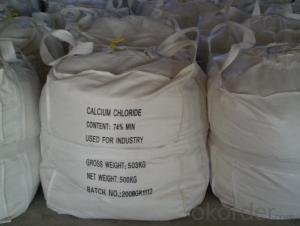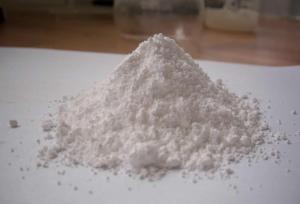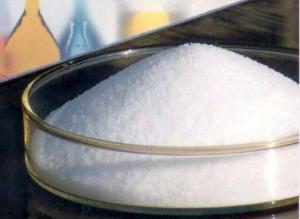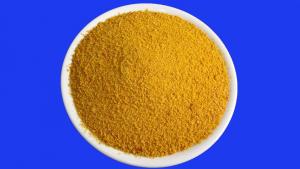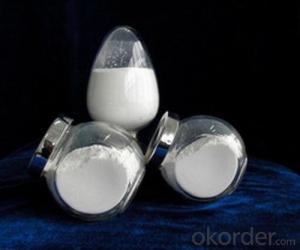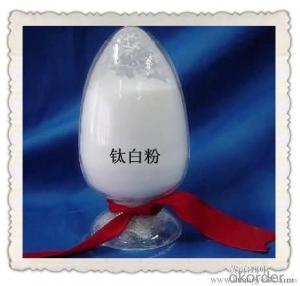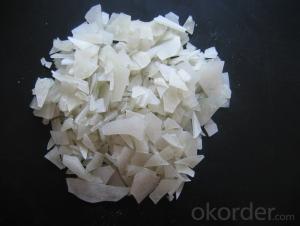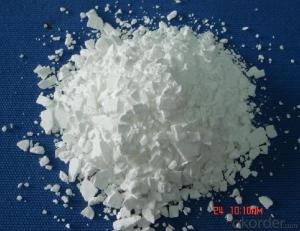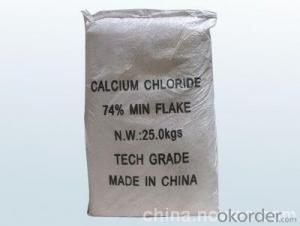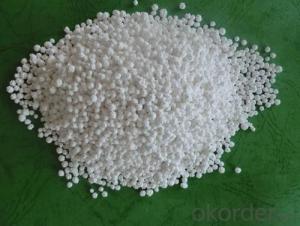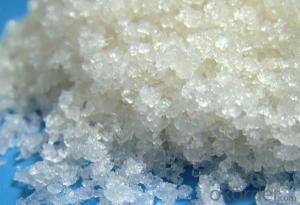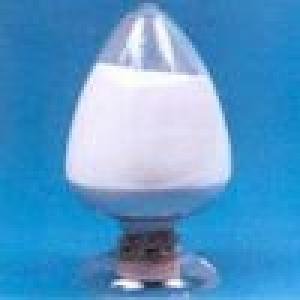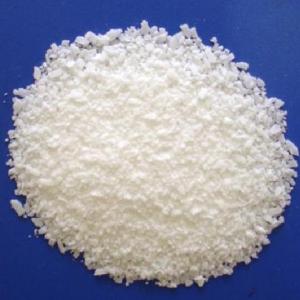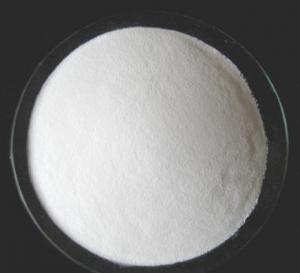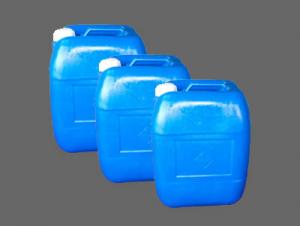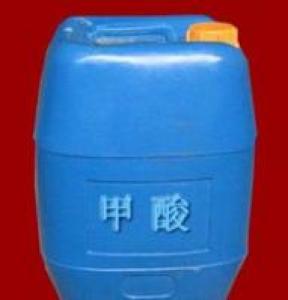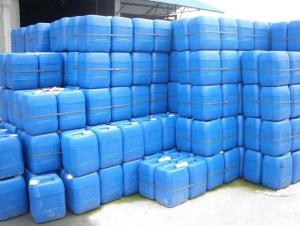Calcium Chloride with Best Quality and Competitive Price
- Loading Port:
- China Main Port
- Payment Terms:
- TT or LC
- Min Order Qty:
- -
- Supply Capability:
- -
OKorder Service Pledge
OKorder Financial Service
You Might Also Like
1. Structure of Calcium Chloride Description:
Property: White flake or grain crystal, its solubility is strong; Easy to dissolve in water. It has causticity.
Molecular Formula: CaCL2 , CaCL2 .2H2O
Molecule Weight: 110.98 , 147.01
CAS No.: 10043-52-4
Appearance: White Flakes / Ball / Powder/Granular
2.Main Features of Calcium Chloride:
calium chloride anhydrous ,cacl2 74% calcium chloride
Calcium chloride is an inorganic salt, which exists as solid or liquid. Solid calcium chloride is a white, crystal
3.Calcium Chloride Images



4.Calcium Chloride Specification
Item (Industrial Grade) | Quality Index | |
Purity ( As CaCL 2 ) | 74-77% | 90-94% |
Sulphate ( As CaSO 4 ) | 0.2 % max | 0.2% max |
Magnesium & Alkali Metal Chlorides ( As NaCL) | 3.5% max | 4.0% max |
Alkalinity ( As Ca(OH) 2 ) | 0.2% max | 0.25% max |
Water insoluble | 0.1% max | 0.2% max |
Item (Industrial Grade) | Quality Index | |
Purity ( As CaCL 2 ) | 74-77% | 90-94% |
Sulphate ( As CaSO 4 ) | 0.2 % max | 0.2% max |
Magnesium & Alkali Metal Chlorides ( As NaCL) | 3.5% max | 4.0% max |
Alkalinity ( As Ca(OH) 2 ) | 0.2% max | 0.25% max |
Water insoluble | 0.1% max | 0.2% max |
Arsenic ( As ) | 0.0002% max | 0.0002% max |
Heavy metals ( As Pb ) | 0.0005% max | 0.0005% max |
5.FAQ
1)How many tons does your factory can supply each moth?
30000tons/month
2)How to quarantee the quality of the products?
you can arrange SGS&BV or other quality inspection.
3)How many days you need to pepare the cargo after we made the order?
within 30 days.
- Q: Why is the vinegar?
- Because it contains acetic acid.
- Q: What foods contain inorganic salts?
- Most of the food contains inorganic salts, the so-called inorganic salts, also known as minerals or ash. Minerals are naturally occurring compounds or natural elements in the crust. There are about 50 kinds of minerals in the human body, although they in the human body only 4% of body weight, but it is an essential part of the organism. Kelp, jellyfish, seaweed, moss; bones, soy products, lean meat, animal liver, brown rice and so on.
- Q: Can you please help me with this question and give me a website reference.
- Many of these materials enter the water through natural channels---minerals, salts and the like come from exposure to rocks, dirt and other inorganic materials.
- Q: Magnesium can constitute chlorophyll, which reflects the nature of inorganic salts
- norganic salt function (1), is the structural component of cells.Many inorganic salts are an important part of some complex compounds in cells.Example: Mg2 + is a necessary component of chlorophyll molecule; Fe2 + is the main component of hemoglobin; calcium carbonate is animal And the body of the bone, an important component of the teeth.
- Q: Last called me to buy salt, but can buy a bag of alkaline powder to go home. Want to know what can use alkali powder?
- Alkaline powder can treat burns. If the scald area pony immediately coated with alkaline powder, and then drop a few drops of water, alkali powder will be dissolved immediately after the water. Was burned parts of the beginning of the alkaline powder coated with a sense of burning, and after a while feel very comfortable ice, like the heat burned alkaline powder is like, so repeated several times can reduce the pain and trauma burns. If the area of burns larger, can be soaked with alkali powder soak for about half an hour or an hour.
- Q: Are the inorganic salts mineral and they are soluble in water?
- Generally speaking, inorganic salts, including minerals, inorganic salts are not minerals. Some inorganic salts can be soluble in water and some can not, the vast majority of minerals do not dissolve in water, otherwise the rain on the rocks are not dissolved Is it gone?
- Q: What is the risk of low inorganic salt?
- Phosphorus into the body of phosphorus containing 750-800mg about 1% of body weight, mineral weight of 1/4. Of which 87.6% in the form of hydroxyapatite bone salt stored in the bones and teeth, 10% with protein, fat, sugar and other organic matter combined constitute soft tissue, the rest distributed in the muscle, skin, nerve tissue and other tissues and membranes Of the ingredients. Function Phosphorus is present in every cell of the human body, which is indispensable for bone growth, tooth development, renal function and nerve conduction. Phosphorus is a component of nucleic acids, phospholipids and certain enzymes, which promotes growth and tissue repair. It helps carbohydrate fat and protein utilization, regulates glycogen breakdown, and participates in energy metabolism. Phospholipids are the major components of the cell membrane, which are related to the permeability of the membrane. Phosphate can regulate the metabolism of vitamin D, to maintain the stability of calcium within the environment. Lack of disease phosphorus deficiency when the mental confusion, cranial nerve palsy, transport disorders, muscle weakness, hypothyroidism, anorexia, joint stiffness, abnormal blood, urinary calcium increased. Typical cases hyperphosphatemia, renal dysfunction, or hypoparathyroidism and hypothyroidism and other endocrine diseases can also occur. Too many symptoms nerve excitement, tetany and convulsions. The physiological requirement of phosphorus is 12.3mg / kg / d. Calcium / phosphorus ratio in the 2: 1-1: 2 appropriate range. Food sources food in the meat, fish, milk, beans and hard shells and other phosphorus more.
- Q: What are the nutritional requirements for bacterial growth?
- The nutritional conditions required for bacterial growth generally include water, carbon, nitrogen, inorganic and growth factors
- Q: What are the effects of water, inorganic salts, carbohydrates, proteins, fats and vitamins?
- The main physiological function of fat: 1. The supply of human heat. (Per gram of fat oxidation can produce 9 kcal of calories, protein and carbohydrates produce more than 2 times.) 2. constitute the body's adipose tissue, adjustable body temperature, To prevent the body outside the scattered, to protect the internal organs, moisturizing the skin. 3. Dissolve nutrients. (Some do not dissolve in water and only soluble in lipids, only in the presence of fat can be absorbed by the body.
- Q: as a example potesium,sodium,magnees,calcium
- The sodium-potassium pump is most important in controlling the working of neurotransmitters. Calcium ion is also generated in voltage gated Ca++ channel, and Magnesium is necessary for metabolic functions. But Sodium is one of the most important inorganic component in our body. Of course Potassium is also as important. But, if you have ever seen the back of all food products there is a special part showing amount of Sodium in it...even Snacks.. :)
Send your message to us
Calcium Chloride with Best Quality and Competitive Price
- Loading Port:
- China Main Port
- Payment Terms:
- TT or LC
- Min Order Qty:
- -
- Supply Capability:
- -
OKorder Service Pledge
OKorder Financial Service
Similar products
Hot products
Hot Searches
Related keywords
